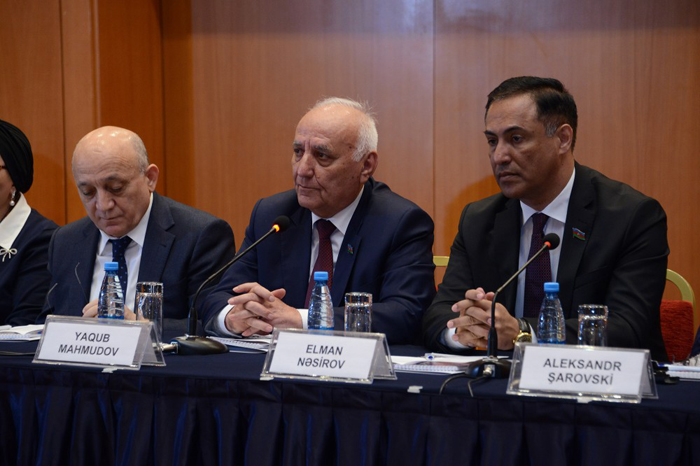
- A-
- A
- A+
“Threats to the Multicultural Environment in Azerbaijan: Armenian Vandalism and the Policy of Genocide for the Last 100 Years”
“Threats to the Multicultural Environment in Azerbaijan: Armenian Vandalism and the Policy of Genocide for the Last 100 Years,” has been organized by the State Committee for Work with Religious Organizations (SCDS) and the Institute of History of ANAS.
The victims of the genocide committed by Armenians at the beginning of the conference were commemorated with a minute of silence.
Speaking at the event, the chairman of the State Committee for Work with Religious Organizations, Mubariz Gurbanli, said the holding of such conferences was of great importance for the disclosure of the crimes committed. He said that after the restoration of Azerbaijan's state independence, it is possible to investigate the crimes of aggression and genocide to declare real truths to the world.
The main purpose of the event was to analyze the history of the Armenian aggression against Azerbaijan and the current situation, discuss the threats to the multicultural environment in Azerbaijan, as well as the tasks in this sphere.
Director of the Institute of History Yagub Mahmudov noted that the main documents related to the genocide Armenians committed against Azerbaijanis in March 1918 were collected during the period of the Azerbaijan Democratic Republic.
“The government created by 26 Baku Commissars in fact was a government of the Armenian Dashnaks, and the letter Stepan Shaumian sent to Lenin after the March genocide testifies to this once again,” he said.
In his letter, Shaumian wrote about the involvement of 4,000 Armenian Dashnaks and added that if not these events, Baku would have become the capital of a state created by Azerbaijanis, Mahmudov noted.
“The documents confirm that the Armenian side assumed several obligations in exchange for obtaining Irevan and the Azerbaijani lands around it, based on the negotiations and treaties in Batumi,” he said, adding that the Armenians were refusing territorial claims against Azerbaijan on the basis of the agreement reached in Batumi.
Those obligations included mobilization of all forces for withdrawal of the Armenian government’s armed forces from Baku, as well as cessation of the mass bloodshed committed by Armenian armed groups against Muslims in Azerbaijan, Mahmudov noted.
“But after achieving their goals, the Armenians unilaterally violated all their obligations and continued the policy of occupation,” he added. “Therefore, both the obligations under the agreement reached in Batumi and the decision of the National Council of the Azerbaijani Democratic Republic, dated May 29, 1918, lost their legal force.”
Mahmudov noted that therefore, it is necessary to reconsider the decision of the National Council of the Azerbaijan Democratic Republic, this decision should be abolished and the Azerbaijanis’ historical inheritance right to Irevan and the territories around it must be restored.
He added that a 9,000-square-kilometer territory was transferred to the Armenians so that they would no longer put forward territorial claims against Azerbaijan.
“The founders of the Azerbaijan Democratic Republic after two months understood the mistake of transferring a 9,000-square-kilometer land to the Armenians,” Mahmudov noted.
Russian historian Oleg Kuznetsov, in turn, said it is necessary to give a legal assessment to the genocide committed in Baku and other regions of Azerbaijan in 1918.
“The bloodshed, committed by Armenians in March-April 1918, was carried out with a particular cruelty,” the historian said.
He noted that Azerbaijani national leader Heydar Aliyev’s announcing March 31 as the Day of Genocide of Azerbaijanis was a right decision and has a legal basis.
In 1918, the Armenian gangs committed acts of genocide against the civilian population throughout the territory of Azerbaijan. More than 50,000 Azerbaijanis became victims of Armenian fascism during five months.
Azerbaijanis were exposed to genocide in Baku, Guba, Shamakhi, Gusar, Irevan, Nakhchivan, Zangezur, Karabakh, Lankaran and practically on all Azerbaijani lands.
Then, scientific secretary of the History Institute, PhD in history Irada Aliyeva, head of the Karabakh history department, PhD in history Gultakin Najafli, head of the Soviet history department in Azerbaijan, PhD in history Ilgar Niftaliyev made presentations.
©All rights are reserved. Citing to www.science.gov.az is necessary upon using news.

 Elm TV
Elm TV
 Photo
Photo
 Video
Video